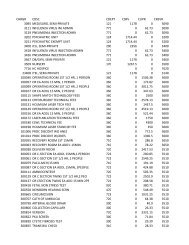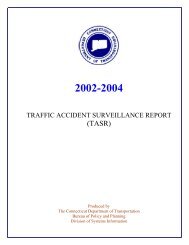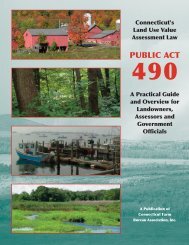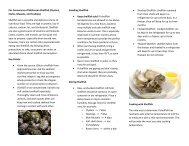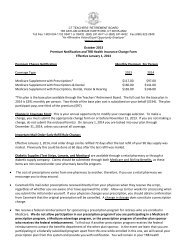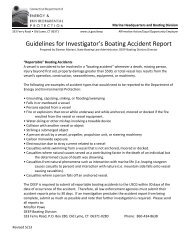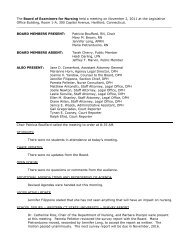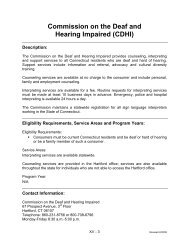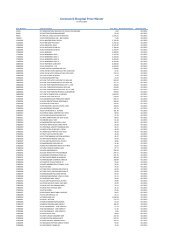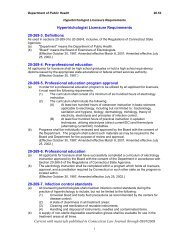2013 CT Anglers Guide - CT.gov
2013 CT Anglers Guide - CT.gov
2013 CT Anglers Guide - CT.gov
You also want an ePaper? Increase the reach of your titles
YUMPU automatically turns print PDFs into web optimized ePapers that Google loves.
Message from the Bureau Chief<br />
One of the things I enjoy most about my<br />
position as Chief of the Bureau of Natural<br />
Resources are the many opportunities I have<br />
to meet with Connecticut sportsmen and<br />
conservation groups. These meetings are<br />
almost inevitably accompanied by questions<br />
on our budget and concerns that money spent<br />
on licenses, permits and stamps is not coming<br />
back to support conservation programs. I am<br />
hoping that the information presented here<br />
will answer most of your questions and address<br />
some of the more common misconceptions.<br />
The Bureau of Natural Resources (BNR)<br />
is divided into four units: Inland Fisheries<br />
Division, Marine Fisheries Division, Forestry<br />
Division, and Wildlife Division. The pie charts<br />
provide a quick look at the sources of revenue<br />
for BNR programs and how it is allocated among<br />
different activities performed by the four units<br />
(for simplicity, spending on Administration has<br />
been combined and spending on freshwater<br />
and saltwater fisheries activities have been<br />
combined). A few things immediately stand<br />
out. On the revenue side it’s clear that anglers<br />
and hunters provide approximately 85% of the<br />
funding for BNR conservation programs. A<br />
willingness to support on-the-ground conservation<br />
is a tradition that sportsmen should<br />
be very proud of. Through the purchase of<br />
licenses, permits, tags and stamps, along with<br />
the federal excise tax paid on the purchase<br />
of fishing and hunting equipment (Wildlife<br />
and Sportfish Restoration Grants), sportsmen<br />
contribute over $13 million per year, clearly<br />
demonstrating a commitment to make longterm<br />
investments in conservation that benefit<br />
all Connecticut residents.<br />
The spending side shows the array of<br />
programs necessary to provide a comprehensive<br />
and effective conservation effort that<br />
cuts across the Connecticut landscape and<br />
serves the diversity of Connecticut residents.<br />
These activities include the conservation of<br />
forest lands, fish & wildlife populations and<br />
their habitats, and elements as diverse as the<br />
management of marine commercial fisheries,<br />
trout and pheasant stocking, control of invasive<br />
species, providing technical assistance to the<br />
public, and conservation of non-game wildlife.<br />
The questions on revenue from the sale of<br />
fishing and hunting licenses, permits, tags and<br />
stamps coming back to support conservation<br />
programs are easy to answer. The federal<br />
<strong>gov</strong>ernment requires that each state pass a<br />
law, as a precondition of accepting U.S. Fish<br />
& Wildlife Service funds, ensuring that all<br />
such revenues are used exclusively to support<br />
fish & wildlife programs (see 26-15 of the<br />
Connecticut General Statutes). Connecticut<br />
sportsmen pay approximately $7.3 million<br />
annually for licenses and other fees. These<br />
revenues are equal to 49% of our BNR operating<br />
funds as shown in the chart below. A<br />
quick look at this chart confirms that all of<br />
the revenue from anglers and hunters does<br />
come back to BNR…plus some additional<br />
monies from the General Fund necessary to<br />
cover current expenses (~7%). In reality, all<br />
Connecticut taxpayers contribute to conservation<br />
via other State and Federal Funds that<br />
are used by the Department of Energy and<br />
Environmental Protection to support our<br />
State Parks, purchase land, and to regulate<br />
activities that have an impact on our natural<br />
environment. The bottom line is that all of us<br />
contribute, and sportsmen in particular have<br />
gone the extra mile and should be especially<br />
proud of what they’ve accomplished. We have<br />
built a solid foundation upon which to meet<br />
future conservation challenges.<br />
William A. Hyatt<br />
Chief, Bureau of Natural Resources<br />
© Detonn | Dreamstime.com<br />
www.ct.<strong>gov</strong>/deep/fishing 5




